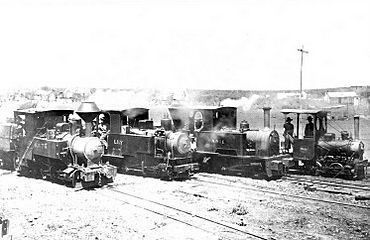Beria, Western Australia facts for kids
Quick facts for kids BeriaWestern Australia |
|
|---|---|

Kalgoorlie and Boulder Firewood Co.'s woodline locomotives Kate, Lily, Anie, and Mary, at Beria, c. 1910
|
|
| Established | 1905 |
| Postcode(s) | 6440 |
| Elevation | 460 m (1,509 ft) |
| Location | |
| LGA(s) | Shire of Laverton |
| State electorate(s) | Kalgoorlie |
| Federal Division(s) | O'Connor |
Beria is a fascinating abandoned town in Western Australia. It's located about 8 kilometers (5 miles) north of Laverton. Once a busy gold mining town, Beria is now mostly a ghost town. Its history tells an exciting story of gold rushes and hard work.
Contents
Beria's Beginnings
The area where Beria stands was officially mapped out and named in 1905. Later, in 1936, a new town area was created just south of the original spot. This was done to give more space between the town and the nearby Lancefield mine.
The local Indigenous Australian people called this area Tinbeeringtharra. However, the name Beria was suggested by a surveyor named John Rowe. Beria is another Indigenous Australian word, meaning large open field.
Discovering Gold at Lancefield
Gold was first found in the area just north of Beria in 1897. Four prospectors named Lemon, Hungerford, Elmes, and Clement made the discovery. Lemon named their mining claim "Lancefield" after his hometown in Victoria.
A man named W. Thomas Horton became interested in the gold find. He was the manager of the Mount Malcolm mine. In 1898, he formed a group called a syndicate to develop the mine.
Early Gold Production
A special machine called a battery was set up near the gold reef. This machine crushed the rock to get the gold out. Production started in January 1899. In less than two years, the battery processed 16,000 tonnes of rock. From this, they recovered 7,200 ounces of gold.
In 1904, a company from London called the Lancefield Goldmining Company took over the mine. Herbert Hoover, who later became the President of the United States, was one of the directors. By 1905, the mine had produced an amazing 54,909 ounces of gold.
Mining Challenges and Solutions
The mine soon faced a big problem. Miners started finding sulphide ores, which are rocks containing minerals like arsenic and copper. These made it difficult to extract the gold. The entire plant had to be shut down and changed.
They reorganized it into a "dry crushing and roasting plant." This meant they would crush the ore dry and then heat it in large ovens called roasters. Each roaster needed 2,000 tons of wood to roast 7,000 tons of ore.
To get all this wood, a special tramway was built in 1908. The Kalgoorlie and Boulder Firewood company built it between the mine and Laverton. This tramway brought wood from the surrounding areas to feed the roasters and boilers. It also supplied wood for supporting the underground mine tunnels.
Changes in Ownership
By 1913, the mine was in liquidation, meaning it was being sold off. In 1914, the Kalgoorlie and Boulder Firewood company bought it. They changed the mine's name to the Beria Consuls Mines.
The mine changed hands again in 1915. The Lancefield company, run by George Ridgway, Dick Hamilton, and Frank A. Moss, took over. The tramway was no longer used and was removed by 1916. The Lancefield company continued to operate the mine until 1940. By the 1950s, the mine had produced over 552,000 ounces of gold and 52,000 ounces of silver.
In 1984, the main chimney-like structure, called a stack, of the mine was taken down.
Modern Mining at Lancefield
Later, as part of the nearby Windarra Nickel Project, another company called WMC Resources started mining gold at Lancefield again. This happened during a time when nickel prices were low. Gold mining at Lancefield continued from 1981 to 1994. The gold ore was processed at the Windarra plant.
During these 13 years, the mine produced 714,884 ounces of gold. They processed over 5 million tonnes of ore, with an average gold content of 4.32 grams per tonne. This shows how much gold was still hidden in the ground around Beria!


